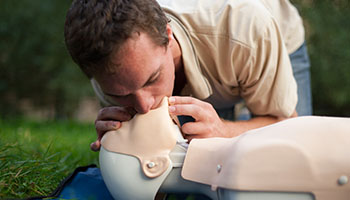HOW CAN WE HELP YOU? Call 1-800-TRY-CHOP
In This Section
Bystander Alert: Rescue-breathing CPR Benefits Children More Than Compression-only CPR

CHOP researchers found that across all pediatric age groups evaluated, rescue-breathing CPR had better outcomes as compared to compression-only CPR for children with out-of-hospital cardiac arrest.
mccannn [at] chop.edu (By Nancy McCann)title="Email Nancy McCann"
Fewer than 10 percent of children who experience cardiac arrest outside of a hospital setting survive, and the rates of survival improve when a bystander performs cardiopulmonary resuscitation (CPR). The American Heart Association (AHA) recommends rescue-breathing CPR for children. Yet, Maryam Naim, MD, MSCE, a cardiac intensivist at Children’s Hospital of Philadelphia, noticed that more of her patients were receiving compression-only CPR when they had their out-of-hospital cardiac arrest (OHCA).
She wondered if this was a nationwide trend: Are more children receiving compression-only CPR? And if so, are their outcomes any different compared to rescue-breathing CPR? These questions set into motion her research study — the first-of-its-kind — into the frequency and types of bystander CPR in pediatric age groups. The research team suspected compression-only CPR might be less effective in children, as pediatric cardiac arrest most often stems from breathing problems, whereas adult cardiac arrest is usually caused by a primary heart problem.
The study results published in the Journal of the American College of Cardiology supported their theory. Rescue-breathing CPR was associated with improved neurologically favorable survival compared with compression-only CPR following pediatric OHCA.
“Children are not simply small adults,” said first author Dr. Naim, “and our study shows there is a tremendous need for education in all communities about the benefits of CPR with rescue-breathing in the pediatric population.”
For more than a decade, the AHA has recommended compression-only CPR for bystanders who witness an adult in cardiac arrest. Data show it’s as effective as conventional CPR, which involves both compressions and rescue-breathing. Today, most lay people and high school graduates are trained in hands-only CPR because it’s simple to teach, easier to learn, and outcomes are similar. It’s the standard of care in adults and teens. But for children, the AHA’s guidelines state rescue-breathing CPR should be performed unless the provider is unwilling or unable to do rescue-breathing, then compression-only should be done.
Analyzing the Age-stratified Data
Using the Cardiac Arrest Registry to Enhance Survival (CARES) database, a large national registry of out-of-hospital cardiac arrests, the study team examined bystander CPR for pediatric, non-traumatic, cardiac arrests between 2013 and 2019.
The researchers, including senior author Joseph Rossano, MD, MS, chief of the Division of Cardiology, identified over 13,000 children between the ages of 0 and 18 with cardiac arrest. Nearly 50 percent received bystander CPR, with compression-only CPR the most common type administered. Narrowing the search to only children with outcome data, close to 10,500 records were further analyzed and stratified into three age groups: under age 1, ages 1 to 12, and greater than age 12 to 18-years-old.
The researchers found that overall across all age groups rescue-breathing CPR had better outcomes as compared to compression-only CPR. And, both types of CPR were associated with a more favorable outcome in teenagers and children over the age of 1, as compared to no CPR. But perhaps the most interesting finding was that in infants — the population with the most cardiac arrests — rescue-breathing was the only effective strategy.
“For infants in particular,” Dr. Naim said, “our study shows that CPR with rescue-breathing is the only type of CPR that is associated with good neurological outcomes; infants who received compression-only CPR had similar outcomes to infants who did not receive bystander CPR. We really need to do a better job emphasizing rescue-breathing CPR in children because they have better outcomes if they receive rescue-breathing.”
The team also examined the changes in rates and types of CPR during the six-year study and found that although the rates of bystander CPR did not change, the proportion of compression-only CPR increased, but with no change in neurologically favorable survival.
“This study has important implications for bystander CPR training,” Dr. Naim said. “While compression-only CPR has likely benefitted adults who have out-of-hospital cardiac arrest, children have most likely been disadvantaged, especially infants. Renewed effort should be made to encourage and educate on rescue-breathing CPR in this population.”